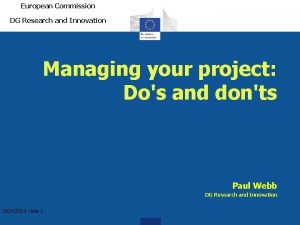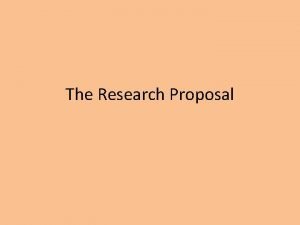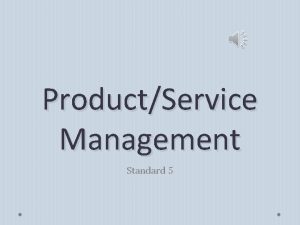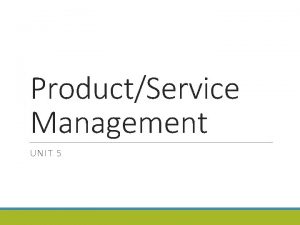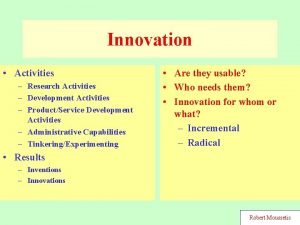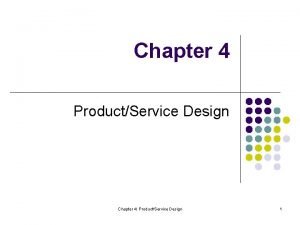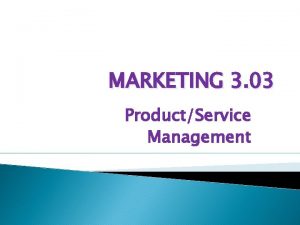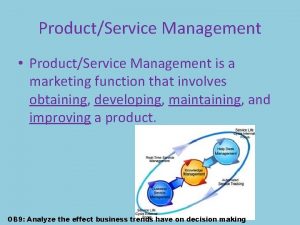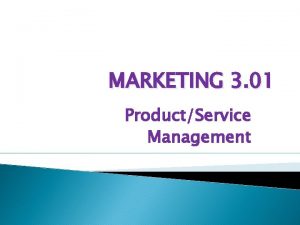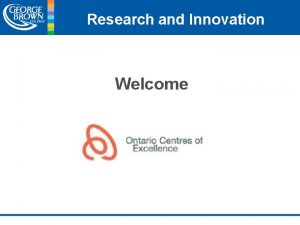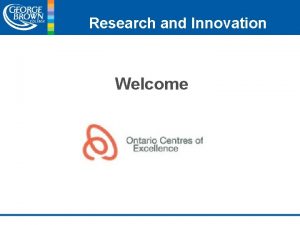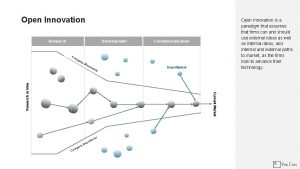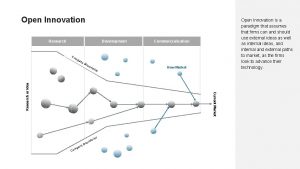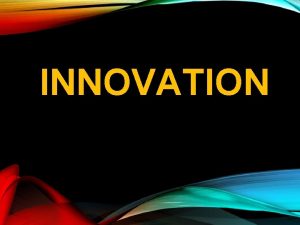Innovation Activities Research Activities Development Activities ProductService Development


















- Slides: 18

Innovation • Activities – Research Activities – Development Activities – Product/Service Development Activities – Administrative Capabilities – Tinkering/Experimenting • Are they usable? • Who needs them? • Innovation for whom or what? – Incremental – Radical • Results – Inventions – Innovations Robert Moussetis

Innovation • Sensing the Urgency to Innovate – Urgency – Impact • Challenges of Finding New Markets for New Technologies – Where do we sell our new products? • Resources and Innovation – Managerial Capability – Financial Commitment – Cultivating the Innovation bug • How and Why Innovation must remain connected with Strategy Robert Moussetis

History of a Strategic Change + NET CASH FLOW + - LIFETIME ROI = + AREA - AREA Ansoff and Mc. Donnell, 1990 Created by Robert Moussetis, 2000

Innovation is Change • Departure from – An established Practice – A method to do things – An approach to solve problems – Established Convictions – Existing products – Existing Services • Arrival at – Uncharted territory – New Methods – New Parameters – New Boundaries – New Services and Products – New beliefs Is the departure sudden or was it planned? Robert Moussetis

Change • Basic System Function • Change is Adaptation to – Environment – Culture -Society – Economies-Politics • Change could be Input x Adaptation Process – Fast, rendering stakeholders incapable of adapting – Slow, rendering stakeholders time to adapt – Complex - Novel – Unpredictable Organizational Boundaries Output y y=f(x) Robert Moussetis

Paradigm • What is a Paradigm? • Why do we use paradigms? • What is a Paradigmic Shift? • What is a Paradigmic Effect? • What is a Paradigmic Filter? • • • Death in the Drawer Paralysis by Analysis Explore the Boundaries Change before you have to Lead, do not manage Control your destiny or someone else will Robert Moussetis

Paradigm Incremental Shift New Paradigm Accepted Paradigm How do we get here? cal i d Ra t f Shi Radical New Paradigm al t n e em digm r c In ara P Robert Moussetis

Change • Incremental Change – Incubation Period Rate of change » Religion Complexity of Change » History Predictability of Change Novelty of Change » Technology • Discontinuous Change – Surprises - Sudden Shifts -Unforeseen Events » Religion » History » Technology Is Change Constant? Robert Moussetis

Paradigm Incremental Shift New Paradigm Accepted Paradigm How do we get here? cal i d Ra t f Shi Radical New Paradigm al t n e em digm r c In ara P Robert Moussetis

Environment • Complexity of Firm’s Environment – Repetitive to Surprising • Relative Novelty of the Successive Challenges – Familiar to Discontinuous and Novel • Rate of change – Slower to faster than capability to respond • Visibility of upcoming changes – Recurring to Unpredictable Robert Moussetis

Organizational Change • Behavioral Orientation of Organization – – – Does the leadership like stability? Does the leadership avoid change? Does the leadership like to react to change? Does the leadership anticipates changes? Does the leadership engages in changes before they have to? Does the leadership creates/dictates the rules of change? • Strategic Behavior - Strategic Aggressiveness – stable-reactive-Anticipatory-Entrepreneurial-Creative Robert Moussetis

Organizational Change – Environment brings change And forces organizational change – Organizations are composed of people with: • Different Behaviors and Capabilities • Different Cultures, Mentality and Systems • Different Perceptions about: – change-leadership-risk propensity-power structure – problem solving-attitude towards change– time perspective-action perspective-change triggers Contingency Change Appropriate to the Organization Is Change Constant? Robert Moussetis

Evolution of Management Systems • Strategic Planning – Analysis of Firm’s Prospects – Competitive Analysis – Strategic Portfolio Analysis • Closes the Competitive Gap • Strategic Posture Management St Environment rat W egi or c k – Diversification Analysis • Long Range Planning – Action Programs, Budgets, and Implementation • Strategic Planning – Balances Prospects against Objectives to produce a strategy Strategy Capability E 1 S 1 C 1 E 2 S 2 C 2 Environment Strategy Capability is introduced into Strategic Management Mentality-Culture-Power Structure Systems-Organizational Structure Capacity

Strategic Diagnosis: Background • Evolution of change • Management confronts two Agenda makes it dangerous Key Problems to base future plans on – Each Organization needs to successful responses to diagnose its unique future historical challenges, threat and • There is no single opportunities prescription for future – Each firm must design and success which will apply to implement its unique response all firms to these challenges

Strategic Diagnosis: Definition • A systematic approach to • Environmental Turbulence is determining the changes a combined measure of the that have to be made to a changeability and firm’s strategy and its predictability of the firm’s internal capability in order environment to assure the firm’s success in its future environment – Complexity – Novelty – Rate of Change – Visibility

Strategic Diagnosis: Example Environmental Turbulence Strategic Aggressiveness Responsiveness of Capability Repetitive Expanding Changing Repetitive Slow Incremental Fast Incremental Stable Custodial Reactive Adapts to Change Anticipatory Seeks Familiar Change Discontinuous Predictable Entrepreneurial Strategic Surprising Unpredictable Creative Flexible

Strategic Segmentation Strategic Information Model Competitive Positioning • How can we systematically “divide” our environment into “workable areas”? • How do we make sure that the information we received from the environment involves legitimate (perceived) information? • How do we systematically design a competitive organization? • How do we interpret qualitative data? • Perception vs. Reality for Organizational Leaders Ansoff and Mc. Donnell, 1990 Created by Robert Moussetis, 2000

SBA: A Strategic Business Area which is a distinct segment of the environment in which a firm does (or may want to do) business • In which SBAs will the firm do business in the future? What competitive position will the firm occupy in each SBA What competitive strategy will the firm pursue to gain this position • • SBA Segmentation • • • SBA 1 SBA SBU Firm SBA 2 Environment • Dimensions: Need, Customer type, Technology and Geography Characteristics: Growth, Performance (Profitability), Turbulence and Success factors Strategic Resource Area: In the resource based postindustrial universe, managers have to balance what they want to do against what they can do Strategic Influence Groups: Firms increasingly legal and societal pressures Stakeholder Management Ansoff and Mc. Donnell, 1990 Created by Robert Moussetis, 2000
 Mysite.socccd
Mysite.socccd Incremental innovation vs disruptive innovation
Incremental innovation vs disruptive innovation Rdi singapore
Rdi singapore Martrat
Martrat Dg research and innovation
Dg research and innovation Action wageningen
Action wageningen Operating activities vs investing activities
Operating activities vs investing activities Which of these sports are indoor outdoor
Which of these sports are indoor outdoor Support activities and primary activities
Support activities and primary activities Examples of primary activities
Examples of primary activities Research report vs research proposal
Research report vs research proposal Method procedure example
Method procedure example What is appendices in research example
What is appendices in research example Distinguish between exploratory and conclusive research
Distinguish between exploratory and conclusive research Research scope meaning
Research scope meaning Qualitative research
Qualitative research Contrast applied research and basic research
Contrast applied research and basic research A research problem
A research problem Research instrument in experimental research
Research instrument in experimental research




